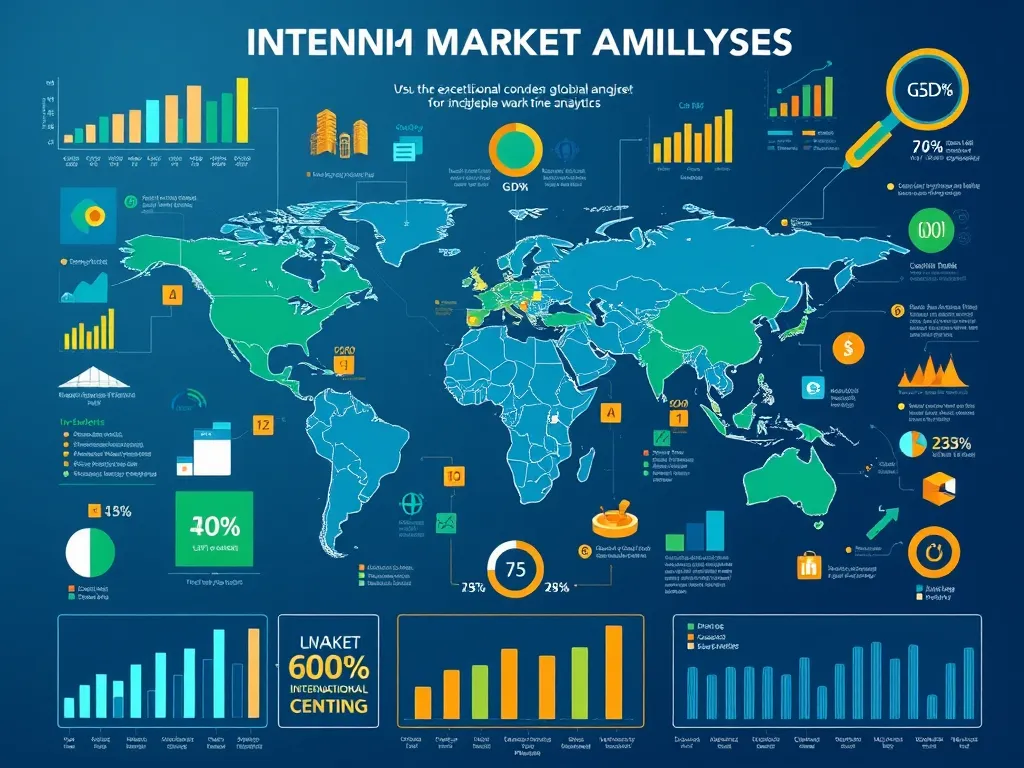Comprehensive Guide to International Market Analysis Strategies

International Market Analysis
International Market Analysis refers to the process of assessing global market dynamics, trends, and opportunities. It is crucial for businesses looking to expand their operations beyond their domestic markets. The analysis involves evaluating various factors, including economic indicators, consumer behavior, competition, and local regulations, to make informed decisions about entering or competing in international markets.
One of the primary objectives of International Market Analysis is to identify new markets that can be tapped into. This entails examining emerging economies that may present lucrative opportunities for products and services. A comprehensive analysis will help businesses understand market maturity, potential growth rates, and the unique needs of consumers in different regions.
Additionally, International Market Analysis focuses on understanding shifts in consumer behavior, which can significantly impact product demand. Factors like cultural nuances, buying habits, and preferences in different countries play a crucial role in shaping market strategies. Companies must adapt their offerings to resonate with local consumers to succeed in international markets.
Moreover, International Market Analysis considers the implications of globalization on trade. As markets become increasingly interconnected, understanding how global events, economic policies, and trade agreements affect various industries is vital. Companies must stay informed about these changes to optimize their strategies and mitigate risks associated with international operations.
Understanding cultural differences is essential for success in global trade, making an effective approach to International Market Analysis crucial.
In summary, International Market Analysis is an essential function for any organization looking to expand globally. This detailed approach not only helps businesses identify opportunities and challenges but also empowers them to make strategic choices that align with their overall objectives.
Global Market Trends
Emerging markets are becoming significant players in the global economy, offering fresh opportunities for businesses. Countries in Asia, Africa, and Latin America demonstrate rapid growth rates, increasing urbanization, and a growing middle class, making them attractive markets for international expansion. Understanding trends within these emerging markets is crucial for companies aiming to capture market share.
Consumer behavior is also evolving rapidly due to technological advancements and globalization. Consumers are more informed than ever before, often using digital platforms to research products and engage with brands. As a result, businesses need to adopt a more customer-centric approach, leveraging data analytics to understand consumer preferences and predict future trends.
Globalization has transformed trade dynamics, with companies now able to operate across borders with relative ease. However, this increased competition necessitates a deep understanding of local market conditions and regulations. Businesses must be acutely aware of how globalization can both offer opportunities for growth and present challenges that require innovative solutions.
Market Entry Strategies
When entering international markets, businesses have two primary options: direct and indirect entry methods. Direct entry involves establishing a physical presence in the target market, such as opening a subsidiary or branch. In contrast, indirect entry might include exporting products or working with local distributors. The choice between these methods depends on factors like market potential, financial investment, and company resources.
Joint ventures and partnerships are another effective strategy for market entry. By collaborating with established local companies, businesses can benefit from their market knowledge, distribution networks, and customer relationships. This approach not only minimizes risks but also enhances credibility in the eyes of local consumers.
Assessing market readiness is crucial for any market entry strategy. This involves conducting thorough research on the target market, including regulatory environments, consumer behaviors, and competitive landscapes. Successful market entry requires careful planning and execution based on well-informed decisions derived from comprehensive analysis.
Competitive Analysis
Identifying key competitors globally is a fundamental aspect of international market analysis. Understanding the competitive landscape in target markets enables businesses to refine their strategies and tailor their offerings to gain a competitive edge. This requires analyzing competitors' strengths, weaknesses, market share, and positioning within the industry.
A SWOT analysis in the international context helps businesses evaluate their internal strengths and weaknesses relative to external opportunities and threats. This strategic tool enables companies to plot their market approach effectively, capitalizing on their strengths while addressing areas that require improvement.
Market share analysis and benchmarking are essential to gauge a company's performance against competitors. Understanding one's position in the market relative to others informs strategic decisions, enabling businesses to identify areas for growth and improvement while enhancing competitiveness.
Cultural Considerations in Marketing
Adapting marketing strategies to local cultures is critical in international markets. Companies must consider cultural differences that influence consumer preferences and purchasing behavior. Tailoring marketing messages to resonate with local consumers enhances relevance and drives better engagement.
Language and messaging adjustments are essential components of effective international marketing. Companies must ensure that their brand messaging is culturally sensitive and linguistically accurate to avoid misunderstandings and build trust with their audience.
Understanding local customs and norms is vital for businesses operating in diverse markets. Companies must be aware of social practices, traditions, and etiquette to navigate their marketing efforts successfully. This cultural sensitivity fosters positive relationships with consumers and can significantly impact brand perception.
Economics of International Markets
Currency fluctuations can have a significant impact on international trade. Businesses must monitor exchange rates to manage risks associated with pricing, profitability, and competitiveness. Understanding currency dynamics helps companies implement effective strategies to mitigate potential financial losses.
Analyzing economic indicators, including GDP growth rates, inflation, and employment levels, provides valuable insights into market potential. These indicators help businesses make informed decisions about where to invest and which markets may present the most promise for international expansion.
Trade agreements and tariffs also play a crucial role in shaping international markets. Businesses need to stay abreast of existing trade agreements and potential tariff implications that can affect their operations and profitability in foreign markets.
Finally, supply chain considerations in global markets are critical. Companies must assess logistics, transportation costs, and regulatory requirements to ensure seamless operations across borders. An efficient supply chain is vital for maintaining competitiveness and meeting customer expectations in international markets.
